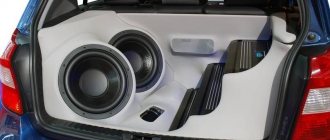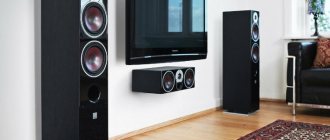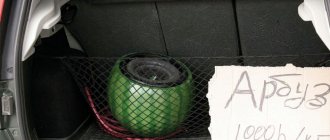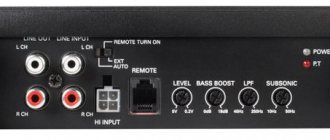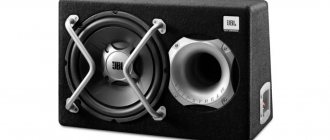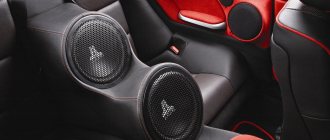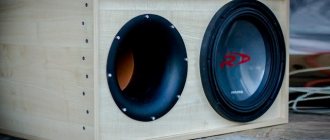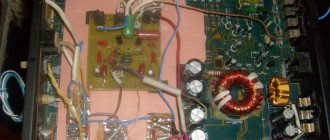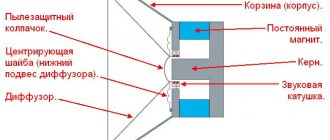Home › Subwoofers ›
27.08.2017
When creating your own subwoofer and for its high-quality and loud sound, you should take into account a large number of important nuances. For example, what kind of speaker for the subwoofer you purchased, how correct is your box, is the amplifier power enough, is the amplifier enough power, etc.
In this article we will touch on one of the many issues that will help you get closer to louder and better bass. Namely, we will answer the question, from what material is it best to make a box for a subwoofer?
Material for making a box for a subwoofer
Material for making a box for a subwoofer
The most suitable material is multi-layer plywood. But out of the wide variety of plywood varieties that exist, not all of them are suitable for making a subwoofer enclosure. So, when using ordinary plywood with insufficient density for these purposes, sound distortion is guaranteed. Another situation is when we are dealing with multi-layer (12 layers) plywood, in the manufacture of which ship wood or Russian birch is used. It is an excellent material for making small sound systems. Such plywood has sufficient density, at the same time, in comparison with such dense materials as particle board (chipboard) and fibreboard (MDF), it is much lighter. Multilayer plywood is easy to process; when screwing in screws, there is no fear that it will delaminate. In a word, plywood is a good subwoofer material for a small volume.
Subwoofer material
–
Plywood or chipboard
It turns out that a plywood sheet with a thickness of 12 mm has better resonance characteristics than boards with a thickness of 16 mm of different types of wood. But it is necessary to take note that large cases made from this plywood ring.
It is simply not acceptable in the manufacture of buildings with large flat spans.
Particle boards. These products are among the most common materials today. In stores and on the market you can find different types of DS boards, but when making cabinets it is recommended to use chipboards
that have the highest density.
True, such slabs are heavier than others, but they are easier to process and sound better. Chipboard with a thickness of 16 mm is perhaps the best material when making powerful low-frequency speaker systems, due to its high density and weak resonant qualities.
Chipboard is one of the inexpensive, readily available materials. True, this material has a significant drawback: it is afraid of moisture, easily absorbs it and swells. Therefore, the chipboard body should be painted immediately after manufacturing. Also, chipboard is very difficult to process with circular or band saws.
— Plywood is a good material, but it is expensive, and with large volumes it makes noise, you need to install stiffening ribs. — Chipboard is cheaper and has greater rigidity.
Source
Acoustic fabric in your car
Acoustic fabric is now successfully used in car sound insulation.
Acoustic fabrics (radio fabrics) are produced for the design of protective grilles of acoustic systems, both automobile and stationary. This modern fabric is made using a special weave of polyester threads, which allows sound waves, regardless of frequency, to pass through the sound-transparent fabric without losing sound power. Today, car acoustics are available to everyone, interior sound insulation is becoming the most fashionable tuning, and of course you can’t do without acoustic fabric.
Materials for making a subwoofer
The choice of material for construction is an important step in the construction process. On this page we will look at what is the best material for a subwoofer enclosure and how to choose it correctly. The main requirements for the box are that it must be rigid, airtight and free of resonances. For example, premium home speakers are very heavy for their type, this is precisely to enhance these three qualities.
The ideal material for a subwoofer would be granite or something similar, but of course car audio cannot afford this - this concerns the weight and complexity of processing. Therefore, the materials used are: chipboard, plywood, MDF, fiberglass. The thickness of the material should be selected based on the volume of the case - the more, the thicker to maintain strength, while for sheet material take 18 mm as a minimum. An exception may be the CV, in which, thanks to a large number of partitions, good rigidity is gained; for it, material from 16 mm can be used.
What is a subwoofer for?
Some car enthusiasts ask themselves the question: do you need a subwoofer in your car? They believe that the full sound of music can be obtained from full-size speakers with a diameter of 16.5 cm. Indeed, manufacturers of audio equipment write that speakers of this size can reproduce frequencies, the lower threshold of which is 20 Hz. This is the minimum frequency that the human ear can perceive.
However, if you delve into this issue in more detail, it turns out that the volume at this frequency is much lower than at a frequency of, say, 1000 Hz. In this case, the sound of instruments such as double bass, bass guitar, and percussion instruments will suffer. Anything that sets the rhythmic pattern of a musical composition will have a weak sound.
This is where the subwoofer comes to the rescue.
Its name itself suggests that it is a low-frequency speaker. They are divided into 3 categories depending on size: 25 cm, 30 cm, 38 cm. The larger the diameter, the higher its volume and the greater the acoustic pressure it creates.
Plywood
Plywood (laminated wood board) is a multilayer material that is made by gluing prepared veneer. To increase strength, layers are applied so that the wood fibers are strictly perpendicular to the previous sheet.
The most popular material for making your own subwoofer. It happens: construction, industrial, packaging, furniture and structural. It’s better to use furniture; if you’re lucky enough to find a structural one, it’s generally great.
Plywood has high strength, is easy to process, and with sufficient thickness gives good rigidity to the body, but can delaminate during assembly.
Medium Density Fiberboard (MDF) - made by dry pressing small wood chips at high pressure and temperature. It is very well suited as a material for subwoofer housings and acoustic speakers in general, as it has a homogeneous structure, absorbs sound well and is easy to process. It has a high density and holds screws well. An MDF box of sufficient thickness is dull, durable, and has no resonances.
Features and types of acoustic fabrics
This material is ideal for decorating any acoustic systems, as it allows you to create an excellent acoustic environment. In production, threads of various thicknesses and any shades are used, thereby obtaining a wide range of textures. Distinctive features of all acoustic fabrics are:
- Their high strength
- Wear resistance
- Resistant to any chemicals
- Practically do not absorb moisture
- Some acoustic fabrics have fire-fighting properties
Glass fabric
Fiberglass is used to make stealth subwoofers or to give non-standard shapes to parts of the housing. The mold is covered with fabric, impregnated with polyester resin. Using such material it is quite difficult to achieve the required thickness, so additional stiffening ribs must be used. In general, making such a case is a labor-intensive process, but the result is aesthetically worth it.
The question is often asked: “Does it make sense to remake a factory subwoofer enclosure?” If you remake the factory housing of a budget sub, there will be an improvement and it will be audible. But since the speaker is most likely bad, it will limit the degree of improvement.
For a high-quality subwoofer, choose the right material. Good luck with your builds!
How can a subwoofer fit organically into the interior of a car?
As mentioned above, the sub should be invisible in the trunk of the car. To achieve this, the Stealth subwoofer enclosure must meet the following requirements:
- Its shape should be thought out in such a way as not to “eat up” the useful volume of the trunk.
- The appearance and texture of the surface should be similar to the factory coating of the luggage compartment. For these purposes, carpet of different colors is used.
- The subwoofer should not interfere with the removal of the spare tire and vehicle tools.
You should never place the Stealth in the spare tire well. Although its volume may be suitable for these purposes, it can easily damage an expensive speaker.
What is the best way to make a subwoofer box with your own hands?
What is the best way to make a subwoofer box?
What is the best way to make a subwoofer box with your own hands? Readers often ask. Let's try to figure it out. This article was written precisely for this purpose. In addition, the reader will receive valuable instructions on how to make a cabinet for this speaker with their own hands. Having found out what would be the best material to make a subwoofer box from, you can safely proceed to the operation.
Preparation of materials and tools
First of all, you need to list a list of tools and materials to get started:
- scissors;
- stationery knife with blades;
- spray paint (matte black);
- ruler;
- roll of self-adhesive carpet;
- soldering iron (for processing carpet around the edges of holes).
Paint is necessary to paint the port so that it does not stand out against the background of the box. You can also paint the joints where the sheets will be connected. It will be enough to paint these places with a small strip. Once you have prepared all the tools and materials, you can begin covering the subwoofer box.
Which material is better
What is the best way to make a subwoofer box?
In principle, there are many materials from which a housing for such a speaker can be made. It can be plywood, MDF, chipboard and so on. Each of these materials has not only advantages, but also disadvantages.
Note. The best material for making a subwoofer enclosure, according to many experts, is shipboard laminated plywood.
Finding ship plywood is not as difficult as it seems at first glance. Construction sites and other manufacturing enterprises have such material. Formwork is often made from this plywood. This material is always moisture resistant, very durable and tough. In a word, for a subwoofer body this is what you need.
Note. It will be useful to know that in the West, where the manufacture of homemade enclosures for subwoofers is highly encouraged, they prefer MDF. They don’t have any marine plywood at all, and many experts see this as the reason for their love for MDF.
Chipboard is also a good material, but it doesn’t like moisture at all. In addition, when processed, chipboard tends to crumble. On the other hand, if you take thicker material, the problem can be solved.
What to make a subwoofer box from
Some experts also recommend other materials, but they are, as a rule, not so popular - for example, glued laminated boards.
What is the best material to make a subwoofer box from?
Reasons for pasting
How to cover a subwoofer with carpet
There are only a few reasons why you may need to cover a subwoofer with carpet:
- If the old coating has worn out and lost its proper appearance. Because of this, the speakers (see How to make your own speakers for a car) will spoil the style of the car;
- If the subwoofer housing was created with your own hands. In this case, pasting with carpet will be the last step in creating the column.
Note: the subwoofer can be covered not only with this material, but also with leather, dermantin or some other material.
Purchased or made yourself
Making boxes for a subwoofer
Making a subwoofer box is a responsible process, but at the same time very interesting. Of course, you can always go to the store and buy a ready-made sub in a housing. But this is a matter for beginners. A professional always buys a subwoofer head separately and then makes the box with his own hands.
Note. The latter option is suitable not only for professionals, but also for people who are passionate about car audio and want to get the most out of the speaker. A subwoofer head placed in a homemade box will produce incredibly strong low-frequency sound.
Before we move on to the manufacturing process, let’s again dwell a little on the topic of purchased subwoofers complete with a housing. As has already become clear, there is no hope for quality here, but the price can attract a buyer. For some models of ready-made cases, the price is only 1 thousand rubles. Needless to say, the material of such a box cannot be expensive. The plywood is always thin, and the box itself cannot even boast of rigidity.
Note. A purchased subwoofer will not give you the right sound. And the same head, if you move it to another box you made yourself, you can connect it so that it sounds much stronger and of better quality.
Manufacturing
Make a box for the subwoofer
What to make a subwoofer box from
Note. When choosing plywood, the main thing is to pay attention to its thickness. Try to select thick plywood, because the rigidity of the entire structure will depend on this, which will ultimately affect the sound. Thus, the optimal thickness for a subwoofer box is considered to be 18 mm. This is quite reasonable: you won’t have to spend a lot of money (the thicker the plywood, the more expensive it is) and the quality will remain at the same level. On the other hand, everyone decides for themselves and sometimes the weight of a homemade box can reach more than 50 kilograms.
Note. Don’t forget to buy a piece of carpet, which we will use to cover the box at the last stage of production.
We are building a building
First of all, we start making the body of the box. Started:
Note. You can do it differently. A hole of normal size is made in the first sheet, and a larger hole is made in the second sheet, which is on the outside. Thus, the subwoofer head will be recessed into the body, which has a positive effect not only on technical capabilities, but also on aesthetic components.
Note. In other words, it is advisable to tighten the screws every 3-5 cm.
Note. Over time, furniture screws do not become loose, even from constant shaking and vibrations.
We protect and modify the hull
Note. It is believed that a closed type of subwoofer box should not have any holes at all. And some experts even recommend checking the tightness of the box by pouring water inside. But this is already overkill and it is unlikely that this should be done.
How to make a box for a subwoofer
At this point, the process of making a subwoofer box with your own hands can be called complete. The instructions should not be ignored under any circumstances. Video reviews and photos are of no small importance - materials that also need to be given attention (see How to cover a subwoofer with carpet: we do it ourselves). Thus, the price of the subwoofer housing will be the lowest, since you will only need to spend money on consumables.
Source
What is the price
Prices for Russian material start at 200 rubles. The most expensive domestic soundproofing material will cost 550 rubles per linear meter. It is usually sold in rolls, the width of which is one and a half meters. The direct competitor to the domestic one is the Chinese brand Mystery. For it you will have to pay from 400 to 600 rubles per meter, and the Chinese roll is 10 cm narrower than ours.
Adhesive-based fabric is more expensive and its price starts from 700 rubles. The roll width can be 1500 mm, and a 700 mm roll of self-adhesive costs about 500 rubles. This type is more elastic, stretches well, is simply cut and quickly glued to the prepared base. Italian, Turkish and Polish materials are also on sale. Among the expensive ones is the finishing of the Stinger company. They ask for it from a thousand per linear meter. This type of carpet is elastic, has different thicknesses and densities, and is available in a wide range of colors.
What material to use to make the subwoofer box.
How to assemble a box for a subwoofer? And most importantly, what? You need to clearly understand one simple thing, the pressure created inside the case when the speaker is operating is similar to water that penetrates into any crack. The point here is that we need to prevent water from seeping in, but instead of water we have air.
First of all, you need to figure out what material the box will be made from. Only one material is ready to suit us and, of course, this is wood. The best option is plywood. Easily processed, not subject to external influences in comparison with chipboard. Namely, swelling when exposed to large amounts of water. Of course, no one is going to pour water on the box, but this is an advantage. The most important thing is that plywood is physically stronger than particle board. Chipboard:
Plywood:
The next option is chipboard. Plywood is sheets glued together, and chipboard is chips that are converted into a slab under a press. The fact is that such a slab is chosen because of its availability. Firstly, it is cheap, secondly, almost all the furniture is made from it, besides, you can simply disassemble the unnecessary cabinet and use the sheets. This is an ideal option for budget systems. In terms of sound properties, chipboard is better than plywood, but as soon as more powerful systems come into play, plywood comes out on top.
Unfortunately, the particle board bends at high power. Sometimes it breaks and crumbles the joints of the bolts that secure the basket. The approximate power of the speakers used in chipboard boxes is eight hundred to nine hundred nominal watts. Roughly speaking, up to a kilowatt maximum. No one can guarantee that even with such power everything will work at the proper level, so if you have plywood, it’s better to use it.
The thickness of the walls is at least one and a half to two centimeters. The front part on which the speaker is located should be made double. If the box is large, and when turned on, one of the walls begins to vibrate, then spacers should be placed inside. Typically the vibration will be where the wall is not supported. Be sure to seal all joints, near the pipe (if the port is a pipe) the same.
How to fasten the walls:
Needs to be secured with screws. Before doing this, we drill a hole with a thin drill so that the screw tightens evenly. If desired, you can recess the hat.
To achieve the strength of the box, we fasten two walls: the front (front) and the back as follows as shown in the figure:
The front side consists of two walls fastened together. This is done to increase durability. If the speaker is low-power, it is permissible not to make the front side of two walls; you can get by with just one.
Source
Why Stealth?
Car subs come in open and closed types. Open ones are installed in the rear parcel shelves or mounted on the back seat, which is not a very good option, since the passenger will feel the full power of musical vibrations.
Closed subs are made in a wooden or plastic case and are installed in the same trunk. Well, subwoofers of the “Stealth” type will help solve the problem of aesthetics and rational use of space.
The name “Stealth” belongs to the American fighter-bomber F-117. This is the first aircraft to incorporate stealth technology for ground-based radars. As for Stealth subwoofers, they are made in such a way as to be invisible in the trunk of a car. When examining the open trunk, they are not noticeable. Also a kind of invisibility.
